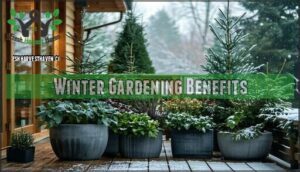This site is supported by our readers. We may earn a commission, at no cost to you, if you purchase through links.

Well-draining potting mix prevents root rot while bubble wrap or burlap shields containers from harsh weather. Monitor watering carefully since winter plants need less moisture.
From vibrant winter blooms to fresh herbs on your windowsill, container gardening gives you complete control over your growing environment. The secret lies in matching plants to your climate zone.
Table Of Contents
- Key Takeaways
- Winter Container Basics
- Winter Gardening Benefits
- Winter Container Plants
- Caring for Winter Containers
- Winter Container Design
- Frequently Asked Questions (FAQs)
- What crops can you grow in pots in the winter?
- What plants can I put in pots for winter?
- What to do with a container garden in winter?
- Can I leave my pots out in the winter with dirt or without dirt?
- When should I start my winter vegetable garden?
- What are the best pots for winter garden?
- Can a container garden be a Winter Garden?
- Are container plants good for winter?
- How do I choose a winter container plant?
- Should you grow winter flowering plants in pots or containers?
- Conclusion
Key Takeaways
- You’ll need frost-resistant containers made from fiberglass, metal, or resin that won’t crack when temperatures drop below freezing.
- Choose cold-hardy plants like pansies, ornamental kale, evergreen herbs, and hardy perennials that can withstand winter conditions in your climate zone.
- Adjust your watering schedule since winter plants need less moisture, and protect containers with insulation like bubble wrap or burlap during harsh weather.
- Create year-round visual interest by combining different textures and heights, pairing spiky evergreens with colorful hardy annuals for striking seasonal displays.
Winter Container Basics
You’ll need frost-resistant containers and well-draining potting mix to keep your winter plants thriving when temperatures drop.
Choose planters that won’t crack in freezing weather, and consider insulating techniques to protect root zones from extreme cold damage.
Choosing Right Planters
The right container materials can make or break your winter gardening success. You’ll need planters that withstand freezing temperatures without cracking, while providing proper drainage and insulation for your plants’ roots.
Consider these essential container materials for winter gardens:
- Fiberglass containers offer lightweight durability and excellent frost resistance for year-round use
- Metal planters like galvanized steel provide strength but may need insulation wrapping
- Resin containers resist cracking and fading while maintaining their appearance through harsh weather
Wooden barrels add rustic charm with natural insulation properties, though they require weatherproofing treatment first.
Reusing Containers
Your old containers deserve a second act in your winter container garden. Before diving into container recycling, inspect each pot for cracks or warping that could spell disaster when temperatures drop. Clean repurposed planters with diluted bleach solution to prevent disease carryover from last season’s plants.
| Container Type | Winter Advantage | Emotional Payoff |
|---|---|---|
| Weathered Terra Cotta | Rustic charm develops | Nostalgic memories bloom |
| Cracked Ceramic | Drainage naturally improves | Imperfection becomes beauty |
| Faded Plastic | Budget-friendly reliability | Guilt-free experimentation |
| Chipped Metal | Industrial winter appeal | Stories etched in patina |
| Worn Wood | Natural insulation properties | Cozy cabin vibes |
Garden upcycling transforms forgotten containers into winter showpieces. Drill extra drainage holes if needed—soggy roots won’t survive freezing nights. These eco friendly tips help you master sustainable gardening while creating stunning winter containers that won’t break the bank.
Insulating Pots for Frost
Without proper pot insulation, your winter container garden faces a losing battle against frost’s relentless assault. Cold shielding transforms vulnerable containers into frost-tolerant strongholds that protect your cold hardy plants through harsh conditions.
Smart winter wrapping techniques safeguard root zones from temperature fluctuations:
- Bubble wrap barriers – Double-layer your containers with this thermal blanket for maximum frost protection
- Burlap shields – Create breathable insulation that prevents moisture buildup while blocking cold winds
- Elevated positioning – Lift pots off frozen ground using blocks or pot feet to prevent cold transfer
These winter plant care strategies guarantee your winter container garden survives when others surrender to frost.
Selecting Well-Draining Mix
During winter months, your soil composition becomes critical for container gardening success. Mix quality potting mix with perlite or coarse sand for best drainage systems. This combination prevents water retention issues that damage root health.
Well-draining potting mixes make sure your winter container garden thrives through freezing cycles while supporting healthy winter plant care.
Winter Gardening Benefits
You’ll discover that winter container gardening transforms cold months into opportunities for fresh harvests and year-round growing satisfaction.
This practice keeps you connected to nature while boosting your mental well-being through the darkest season, proving that productive gardening doesn’t end with the first frost.
Year-Round Gardening Experience
Container gardening breaks the traditional growing season barriers, giving you complete control over your Year-Round Harvesting schedule. You’ll master Seasonal Planting techniques while developing sophisticated Garden Planning skills that work in any climate.
This approach teaches you proper Soil Preparation methods for different seasons and helps you create stunning Container Arrangements that evolve throughout the year.
Your Winter Container Garden becomes a living laboratory where you experiment with timing, plant combinations, and microclimate management—skills that transform novice gardeners into confident growers who never stop harvesting.
Fresh Produce During Winter
Fresh winter vegetables from your containers beat expensive grocery store produce every time. Your container vegetable gardening setup delivers nutrient-dense cool-season crops like kale, spinach, and carrots right outside your door.
Winter harvesting means you’ll enjoy peak flavors while frost-tolerant varieties thrive in cold frames, giving you control over your food supply when prices soar.
Connection to Nature
Beyond fresh harvest rewards, your Winter Container Garden becomes a bridge to Nature Therapy and Outdoor Wellness. Container Gardening with Evergreen Plants creates an Eco Friendly sanctuary that provides Wildlife Benefit through seed-bearing Winter Plants. This practice fosters Seasonal Harmony, keeping you grounded in natural rhythms. Your Winter Garden Design transforms outdoor spaces into healing environments where you can:
- Watch birds feast on ornamental berries you’ve grown
- Feel soil between your fingers on mild winter days
- Breathe in fresh pine scents from dwarf conifers
- Observe frost patterns forming on hardy leaves
- Experience quiet moments among your thriving winter plants
Improved Mental Health
Gardening acts as nature’s antidepressant, offering powerful mood boosters and stress relief when you need it most. Mindful gardening with your winter container garden creates therapeutic benefits that combat seasonal depression.
Tending winter containers becomes your natural therapy session, delivering stress relief and mood boosts when seasonal depression hits hardest
Tending winter plants and evergreen plants provides daily purpose and accomplishment. These winter gardening tips transform cold months into opportunities for emotional wellness and mental clarity.
Winter Container Plants
You’ll find that selecting the right cold-hardy plants transforms your winter containers from bland to vibrant, even when temperatures drop below freezing.
Choose perennials like coral bells and evergreens such as dwarf conifers alongside hardy annuals like pansies and ornamental kale to create displays that withstand winter’s harsh conditions while adding much-needed color to your outdoor space.
Hardy Annuals for Containers
While winter brings dormancy to most gardens, hardy annuals turn your Winter Container Garden into a vibrant showcase. These frost-tolerant champions thrive when temperatures drop, giving you Winter Blooms that last months.
Your Container Gardening success starts with selecting plants rated for your climate zone. Here are five powerhouse Hardy Annuals for Container Arrangements:
- Pansies – Cheerful faces that handle temperatures down to 15°F with proper Pansy Care
- Ornamental Kale – Purple and green rosettes that intensify in cold weather
- Hardy Cyclamen – Heart-shaped leaves with delicate pink or white flowers
- Snapdragons – Tall spikes of color that bounce back after light frost
- Calendula – Golden blooms that attract beneficial insects even in winter
These Winter Plants need well-draining soil and containers with drainage holes. Position them where they’ll catch maximum sunlight during shorter winter days. Water sparingly once growth slows, keeping soil moist but never soggy.
For a beautiful display, consider using frost hardy annuals to add color and texture to your containers.
Evergreen Herbs for Containers
Mediterranean Cold Hardy herbs like rosemary, thyme, and sage excel in Container Gardening during winter months. These Evergreen Perennials thrive with proper Herb Selection and adequate Container Size. Use well-draining potting mix for best Soil Quality. Winter Pruning maintains compact growth while providing fresh harvests. Regular Evergreen Care includes protecting from harsh winds and reducing watering frequency.
| Herb | Container Size | Cold Tolerance |
|---|---|---|
| Rosemary | 12-16 inches | Zone 6-9 |
| Thyme | 6-8 inches | Zone 4-9 |
| Sage | 10-12 inches | Zone 5-9 |
| Lavender | 12-14 inches | Zone 5-9 |
| Oregano | 8-10 inches | Zone 4-9 |
Winter-Blooming Plants
Three stunning winter blooming plants can transform your containers into seasonal showstoppers. Pansies deliver cheerful faces in purple, yellow, and white throughout winter’s coldest months. Hardy cyclamen provides elegant swept-back petals in pink and white, thriving in cool temperatures. Winter-blooming camellias offer rose-like blooms when you need seasonal colors most.
These cold hardy champions require proper flower care—well-draining soil and protection from harsh winds. Your winter container plantings will showcase vibrant winter flowers that prove garden planning pays off during dormant seasons.
Cold-Hardy Perennials
Beyond winter blooms, evergreen perennials form your container garden’s backbone. These cold hardy champions like coral bells and hardy sedums handle frost with ease.
Perennial care involves selecting proper container selection – choose pots two zones hardier than your area.
Hardy plants like bergenia and hens-and-chicks offer year-round structure while frost tolerance keeps them thriving through harsh winters in your container gardening setup.
Caring for Winter Containers
Winter container care requires adjustments to your regular gardening routine since plants face harsher conditions in pots than in the ground. You’ll need to monitor watering frequency, protect containers from temperature extremes, and watch for common winter pests that target stressed plants.
Watering Needs During Winter
Your winter container plantings need adjusted watering since cold hardy plants use less water during dormancy.
Check soil moisture weekly by inserting your finger two inches deep. Winter irrigation should keep soil slightly moist but never soggy—overwatering kills more frost-tolerant plants than underwatering.
Cold weather watering requires balance: too much creates root hydration problems, while bone-dry soil offers zero frost protection for your container plant care routine.
Fertilizing Winter Plants
Your winter plants don’t need much feeding since they’re in dormancy mode. Skip nitrogen-heavy winter fertilizers that push unwanted growth.
Apply balanced organic feeds and soil amendments in fall, then pause until spring. Watch for yellowing leaves indicating nutrient deficiencies.
Cold climate nutrients work best for gentle container plant care during cold-hardy seasons.
Protecting Plants From Cold
Container plants need your help surviving winter’s brutal assault. Cold-hardy plants won’t cut it when temperatures plummet and freeze prevention becomes your main concern.
Frost Protection Methods keep winter containers thriving:
- Wrap pots with bubble wrap or burlap for insulation methods that shield root zones
- Create cold frames using hay bales around grouped containers
- Apply winter mulching around pot bases, extending protection upward
Frost-tolerant varieties still benefit from these strategies. Smart placement near buildings provides natural windbreaks, while insulation methods prevent freeze-thaw cycles that crack containers and damage roots in cold climates. When selecting plants, consider using cold tolerant plants to help your winter garden thrive.
Monitoring for Pests
Despite winter’s slower pace, pest control methods remain essential for winter container gardens. Check your outdoor container gardens weekly for aphids, spider mites, and scale insects that exploit protected spaces during the winter months.
With natural predators dormant, you’ll need organic pest solutions like neem oil or insecticidal soap for effective winter insect management. Practice thorough container inspection and make certain proper spacing for good air circulation.
Remember, vigilant monitoring beats reactive treatments every time in container gardening.
Winter Container Design
You’ll create visual impact when you combine plants with different textures and heights in your winter containers.
Strategic placement of evergreen focal points alongside colorful hardy annuals transforms ordinary pots into striking seasonal displays that brighten your outdoor space.
Incorporating Lighting
Proper lighting elevates your winter container gardens from forgotten corners to stunning focal points. Solar lighting offers eco-friendly illumination, while string lights and fairy lights create a magical ambient glow around evergreens and cold-season crops. LED options provide energy-efficient solutions that won’t break your budget.
Consider these lighting approaches for maximum impact:
- Position grow lights above leafy greens to support photosynthesis during short winter days
- Wrap fairy lights around container rims to highlight plant textures and create warmth
- Use solar spotlights to uplight specimen plants like dwarf conifers or ornamental kale
- Install timer-controlled LED strips underneath planters for dramatic uplighting effects
Strategic placement transforms ordinary container gardening into enchanting winter displays.
Creating Rustic Winter Look
Natural materials bring authentic charm to winter containers. Weathered textures and earthy tones create that perfect rustic appeal you’re after. Your winter landscape transforms when you embrace vintage accents alongside evergreen perennials for container gardens.
Key elements for rustic winter containers:
- Reclaimed barn wood planters with naturally aged finishes
- Burlap wraps secured with twine for cozy elements
- Galvanized metal buckets that complement cool-season crops beautifully
Using Contrasting Plants
Through strategic plant pairings, you’ll transform bland Winter Containers into enchanting displays. Mix spiky evergreens with soft ornamental kale to showcase diverse Plant Textures. Pair silvery dusty miller against deep purple pansies for striking Color Combinations.
These Foliage Varieties create vibrant Garden Layers that catch attention year-round. Your Container Garden Ideas should emphasize contrasts—rigid conifers beside cascading ivy, or tall ornamental grasses with low-growing cyclamen.
These Ornamental Plantings prove winter gardening doesn’t mean sacrificing visual appeal.
Adding Color to Winter Garden
Winter’s palette doesn’t have to be dull when you master colorful foliage combinations. Transform your containers into vibrant displays using winter flowering plants that thrive in cold temperatures.
Create stunning seasonal themes with these garden accents:
- Bold Winter Blooms – Combine bright pansies with purple ornamental kale for eye-catching contrast
- Textured Evergreen Shrubs – Layer winter heather with spiky conifers for lively visual interest
- Vibrant Textures – Mix silvery dusty miller with burgundy cabbage for rich depth
These combinations guarantee your winter containers remain showstoppers throughout the coldest months.
Frequently Asked Questions (FAQs)
What crops can you grow in pots in the winter?
Ready to harvest winter’s bounty right from your patio? You can grow hardy leafy greens like kale and spinach, plus root vegetables such as carrots and beets in containers throughout winter.
What plants can I put in pots for winter?
You’ll find success with evergreens like boxwood and mugo pine, perennials such as coral bells and hardy heuchera, plus colorful annuals including pansies and ornamental kale.
Choose plants two zones hardier than your area.
What to do with a container garden in winter?
Container plants need superhero-level protection to survive! Water sparingly until soil freezes, insulate pots with bubble wrap, and move tender plants to sheltered spots like unheated garages.
Can I leave my pots out in the winter with dirt or without dirt?
You can leave pots outside with dirt, but they’ll need frost-resistant containers and proper drainage. Empty pots are safer from cracking but won’t insulate plant roots if you’re overwintering perennials.
When should I start my winter vegetable garden?
While others scramble with spring fever, savvy gardeners know you’ll start your winter veggie plot by late summer.
Plan your seed starting between mid-summer to early autumn for fresh winter harvests.
What are the best pots for winter garden?
Choose frost-resistant fiberglass or heavy-duty plastic pots with excellent drainage holes. You’ll want containers that won’t crack when temperatures drop below freezing.
Can a container garden be a Winter Garden?
You’ll transform any outdoor space into a vibrant winter wonderland using containers. Hardy plants like evergreens, ornamental kale, and winter pansies thrive in pots, creating stunning displays that’ll brighten those dreary months.
Are container plants good for winter?
Container plants thrive in winter when you select hardy varieties. While tender plants struggle, cold-tolerant perennials and evergreens flourish.
You’ll enjoy year-round gardening success with proper plant selection and container protection.
How do I choose a winter container plant?
Pick plants rated two USDA zones hardier than your area. Perennials like lavender, evergreen shrubs like boxwood, hardy Christmas ferns, and cold-tolerant flowers like pansies are all great options.
Focus on evergreens for structure and colorful annuals for winter interest.
Should you grow winter flowering plants in pots or containers?
Yes, you should grow winter flowering plants in pots. Containers offer better root protection, mobility during harsh weather, and easier monitoring.
Choose cold-hardy bloomers like pansies, cyclamen, or winter heather for reliable color.
Conclusion
Despite concerns about winter weather killing container plants, winter gardening in containers actually extends your growing season with proper planning. Frost-resistant containers and cold-hardy plants create stunning displays while providing fresh herbs and vegetables.
Your winter containers need less water but require protection from freezing temperatures. Choose evergreen herbs, winter-blooming flowers, and hardy vegetables for success.
Winter gardening in containers rewards patient gardeners with year-round beauty and fresh produce right outside your door.
- https://ubigro.com/year-round-success-greenhouse-gardening-guide/
- https://content.ces.ncsu.edu/preparing-nursery-plants-for-winter
- https://platthillnursery.com/winter-gardening-essential-tips-and-strategies/?srsltid=AfmBOooel6gV5cxrSztN9eINkYsziD25ZRtYcJQ0MMMM4NRoKKA9uT21
- https://ucanr.edu/site/uc-master-gardeners-santa-clara-county/container-gardening-basics
- https://www.bhg.com/gardening/vegetable/vegetables/growing-vegetables-in-containers/




